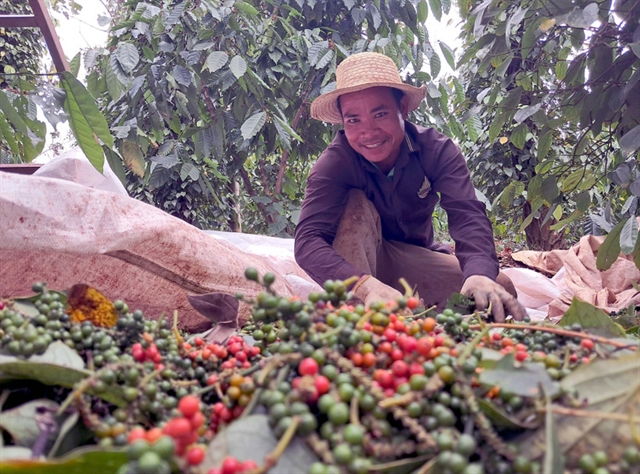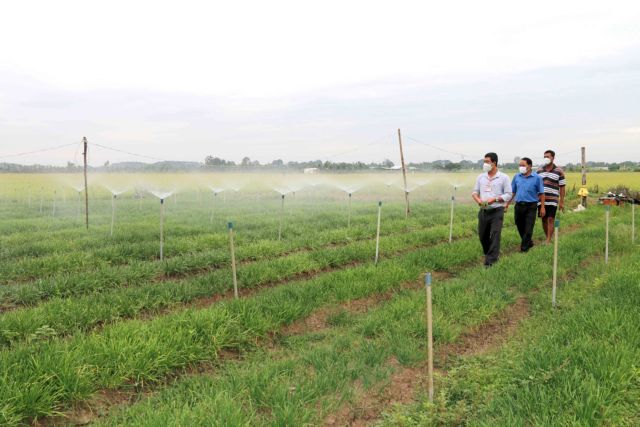 Society
Society

 |
| A field under garlic chives in Trà Vinh Province’s Châu Thành District that is equipped with an automatic irrigation system. — VNA/VNS Photo Thanh Hòa |
TRÀ VINH — The Cửu Long (Mekong) Delta province of Trà Vinh is stepping up the adoption of advanced farming techniques and models.
Nguyễn Huỳnh Thiện, deputy chairman of its People’s Committee, said the province is strengthening research and applying advanced technologies to produce new and key products, especially agricultural products.
It has earmarked VNĐ150-200 billion (US$6.3-8.5 million) for these activities in the 2022-25 period, according to the province's Department of Science and Technology.
It is also focusing on the registration of brand names for key products at home and abroad, Thiện said.
Lâm Thái Hùng, deputy director of the department, said some 120 plans, projects and farming models are in the works, and priority would be given to advanced techniques, new materials and environmental protection.
The province plans to increase agricultural output by VNĐ500 billion ($21.2 million) this year to VNĐ30 trillion ($1.27 billion), and average output per hectare by 2025 is ranged from VNĐ15 million ($630) to VNĐ145 million ($6,100).
Implementation
Lê Văn Đông, deputy director of the province's Department of Agriculture and Rural Development, said the transfer of know-how to farmers and expansion of new farming models have helped effectively restructure agriculture, implement safe production processes and improve agricultural value chains.
Nearly 26,000ha use automatic irrigation, net houses, hydroponics, Vietnamese and global good agricultural practices (VietGAP and GlobalGAP), or organic farming methods.
Models using advanced techniques are extremely efficient and offer farmers profits three to 10 times those brought by traditional methods, according to the agriculture department.
Vegetables grown in net houses equipped with automatic irrigation to VietGAP standards fetch 10-15 per cent higher prices than normal.
Đông said the province plans to help farmers use efficient irrigation methods for all dry crops to reduce the use of water by 30 per cent.
It subsidises equipment and installation costs by 50 per cent up to a maximum of VNĐ40 million ($1,700) per hectare.
It also subsidises rice field levelling costs by 50 per cent.
Localities with elevated areas and sand dunes such as Cầu Ngang, Trà Cú, Duyên Hải districts and Duyên Hải Town have efficient irrigation systems for nearly 12,000ha.
Thạch Thanh of Cầu Ngang District’s Hiệp Hoà Commune spent VNĐ100 million ($4,200) on installing an automatic irrigation system for his one-hectare peanut field in 2021.
The cost upfront was high but he saves wages for labourers irrigating the land, water by 60 per cent, and the use of fertilisers and pesticides by 30 per cent, he said.
His yield is 10 tonnes per hectare per crop, three times the output traditional farmers get, he said.
“I earn VNĐ60 million ($2,500) from a crop,” he said.
The province plans to expand the area under vegetables and help rice farmers adopt the wet-dry irrigation method.
It encourages farmers to join agricultural co-operatives so that they can easily get soft loans for investing in efficient irrigation systems.
The department pushes for adoption 13 farming models assessed as effective last year, including giant river prawn-rice farming, hi-tech two-stage white-legged shrimp breeding, breeding Grimaud super meat ducks, growing honeydew melon in polygreen houses equipped with drip irrigation systems, growing peanut using organic fertilisers and efficient irrigation, and growing the global award-winning ST 25 rice variety.
Farmers in the province have switched to growing other crops or breeding aquatic species on nearly 5,600ha of unproductive rice fields since 2021.
These fetch them incomes of VNĐ100-150 million ($4,200-6,300) per hectare per year, five to 10 times the income from rice, according to the department. VNS